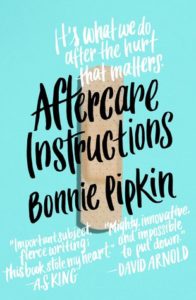In recent years I’ve noticed a Juno Effect in contemporary YA novels featuring pregnant teenagers. As in the blockbuster 2007 movie Juno, the protagonist ends up carrying the pregnancy to term—or if she doesn’t, the issue is conveniently resolved when the pregnancy is lost to miscarriage. Publishers with their eye on the bottom line feel they need to please everyone, which means that if a book portrays a teenage girl getting an abortion, too many schools, libraries, and individual book buyers will turn away.
But self-censorship means that many teens’ experiences are not being represented, and one-sided representation is, in fact, having its own impact. In 2011, a quarter of teen pregnancies ended in abortion, down from a peak of 43 percent in the mid-1980s.
 For this reason, Bonnie Pipkin’s debut YA contemporary novel Aftercare Instructions is a brave, bold, and necessary title. The novel begins in a Planned Parenthood clinic. (It should be noted here, that Planned Parenthood has faced relentless persecution over the past few years, including defunding in many states, infiltration by right-wing videographers, violent attacks, and trumped-up criminal charges based on the falsified videos.) After enduring the procedure, 17-year-old Genesis returns to the waiting room to see her boyfriend Peter gone. He was supposed to help her get back to her home in suburban New Jersey, but he has abandoned her and won’t return her panicked calls. She ends up getting help from a cousin, a student at NYU. Over the next few days, Gen meets aspiring actor Seth, attends a party in Brooklyn with her cousin, and confronts crises back home with her mother, Peter’s conservative Christian family, and Peter himself.
For this reason, Bonnie Pipkin’s debut YA contemporary novel Aftercare Instructions is a brave, bold, and necessary title. The novel begins in a Planned Parenthood clinic. (It should be noted here, that Planned Parenthood has faced relentless persecution over the past few years, including defunding in many states, infiltration by right-wing videographers, violent attacks, and trumped-up criminal charges based on the falsified videos.) After enduring the procedure, 17-year-old Genesis returns to the waiting room to see her boyfriend Peter gone. He was supposed to help her get back to her home in suburban New Jersey, but he has abandoned her and won’t return her panicked calls. She ends up getting help from a cousin, a student at NYU. Over the next few days, Gen meets aspiring actor Seth, attends a party in Brooklyn with her cousin, and confronts crises back home with her mother, Peter’s conservative Christian family, and Peter himself.
Pipkin narrates her novel mostly through Gen’s first person perspective but also through Gen’s four-act play that illustrates her confronting her troubled past with both her mother and with Peter. The dialogue, in both the play and the traditional narrative, is snappy and realistic, revealing each character’s desires as it moves the story forward. Strong secondary characters complement the lead and raise the conflict and stakes. By focusing on the immediate aftermath of Gen’s abortion and compressing the story into a fateful week, Pipkin ratchets up the tension while exploring in depth the impact of Gen’s choices. In the end, the abortion isn’t the main focus of the book, but it serves as a catalyst for a series of life-altering decisions as Gen struggles to break from unhealthy relationships and build a future based on what she wants rather than what others want from her.